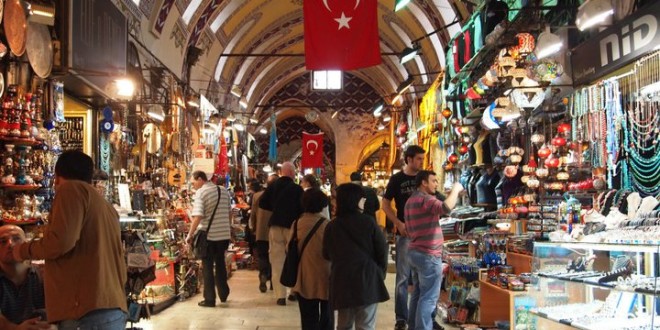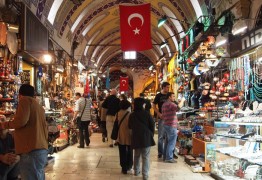Istanbul’s Grand Bazaar is often derided as an enormous tourist trap, and indeed a quick stroll through it can confirm this impression. Vendors of cheap scarves, tea sets and ceramic bowls stand in front of their shops, competing loudly for customers: “Excuse me, would you like to see my shop?” “I am right here!” “Hello, where are you from?” The size of this mall-precursor is overwhelming and its labyrinthine aisles are confounding. Early in our stay here, having purchased my fill of scarves, apple-flavored tea and fake-gem bracelets, I vowed I was finished with the place. I managed to avoid going there for over a year. But now I am back.
Why? Well, I’ve discovered that, like nearly everything else in Istanbul, the Bazaar has a long history. Many of its products are the results of years of refinement. Visiting the Bazaar lends a historical perspective to Turkish gold, silver, leather crafts and textiles. The Bazaar is a self-contained community, and navigating it is an orienteering challenge, but it is deeply satisfying when you finally begin to crack the code.
How can I begin to explain the Grand Bazaar? Picture a shopping mall in the United States. A large one, its stores spread over 76 acres. Now make it over 500 years old, and give it about 4,000 shops.
 |
| The main gate of Istanbul’s Grand Bazaar |
Then take all the different kinds of merchandise in the mall – shoes, jewelry, towels, plates and silverware, wallets, clothing – and group these items together. Give jewelry one wing, shoes another, and provide other spaces for fur, leather, rugs and antique silver and gold.
Then, add narrow passageways that wind from each specialized retail section to two-story enclosed courtyards where the items are crafted. Add to these courtyard-buildings — we will call them hans — space for out-of-town merchants to stay while they are visiting with their wares.
 |
| A narrow passage brings you to this picturesque han where goldsmiths and jewelers work. |
Add restaurants serving staff as well as patrons. Add teashops from which tiny cups of tea can quickly be delivered to favored customers. And, since merchants at the mall work long hours and cannot leave to do their prayers, add small places to worship.
 |
| Stairway leading to tiny mosque |
The concept of the han goes back to the era of itinerant merchants. Here are some details from the delightful book, Istanbul’s Bazaar Quarter: Backstreet Walking Tours, by Edda Renker Weissenbacher and Ann Marie Mershon (a native of Grand Marais, Minnesota).
“The word “han” means house in Persian. The oldest existing han in Istanbul . . . was built between the 4th and 5th centuries, during the Byzantine era. Most of the hans were constructed during the Ottoman Empire and the majority of those still standing date back to the 18th century.
“Hans. . . consisted of an open porticoed-courtyard surrounded by two or three stories of rooms, usually built of heavy stone or a combination of stone and brick. The windowless ground-floor rooms were used either to store goods that had been transported for sale or as stables. Upper-story rooms were shared by four to six people. In the evening they laid their mattresses on the floor of their rooms and in the morning rolled them up and stashed them into alcoves or cupboards to make space for daytime activity. While some rooms were used for sleeping, other were dedicated to working at a trade. . . Many people spent their days distributing merchandise or selling it on the streets or in the bazaar.
“Nearly every han had a fountain in the courtyard and a kitchen. . many also had a small mosque or a prayer room. . . Some hans housed different populations, perhaps Persians or Jews, so their places of worship reflected the specific population of the han.”
So we have the bazaar itself and then the supporting hans. Of course these days, many items are made outside Istanbul, outside Turkey. Some hans still function while others are crumbling. In the course of many visits to the Grand Bazaar, I have not only navigated its passageways and drunk its tea, but peered into a dozen or so hans and come upon some unusual products. Let’s go and see some of them.
First, as you approach the main gate of the Bazaar, there is a sebili that I’d like to tell you about. A sebili is a small decorative kiosk located alongside a mosque, where cups of water or tea were traditionally handed through decorative gratings to thirsty passersby.
 |
| A typical sebili |
An enterprising family has restored the sebili below (notice its characteristic roof), located just outside the Bazaar and adjacent to the Nuru-Osmaniye Mosque, and turned it into a carpet shop.
 |
| The Nuru-Osmaniye Sebile |
Cengis Belli, (above, far left) one of the owners, greeted us outside on a snowy day and invited us inside to drink tea and warm up. It was heavenly.
Cengis has an interesting array of rugs and also some old Anatolian plows made of wood with thin, embedded stones that served as blades.
Now let’s go inside the bazaar and get our bearings.
| These gold bracelets somehow remind me of sweet rolls! |
| Kilim carpets and pillows from the elegant Adnan and Hassan shop |
 |
| Hand-dyed fabric. . . |
 |
| . . . made into lovely home furnishings. |
| Leather puppets representing Turkish folk characters, from L’Orient shop |
| Exquisite old “lunch boxes,” each with five compartments; and old lantern. L’Orient shop |
 |
| Colorful igne oyasi (delicate needlework) necklaces from Antica Murrina |
Just when the shopping is getting a little tedious, we stumble upon several stores that have really different items and make some new friends.
Hidayet Mahdum and his sales associate, Kemal, are from Afghanistan by way of Turkmenistan. When Turkmenistan and the Soviet Union were at war in the early 1990s, Hidayet and Kemal came as refugees to the northern Afghan city of Mazar-i-Sharif. Now they live in Istanbul,and for two years have sold antique Central Asian jewelry and felt objects at Ak Gumus Tribal Arts in the Grand Bazaar. Kemal tells me that his father doesn’t allow him to go to Afghanistan on purchasing trips — it’s too dangerous.
Shakir is Hidayet’s brother. His English is excellent and he tells me of the multiple Central Asian languages he can speak. He has just opened another tiny shop near Ak Gumus called Ayaz Tribal Otantico. It is so new it doesn’t have a proper sign yet!
| Some of the lovely items Shakir sells. The brothers also sell exquisite menorahs. |
These days, when I’m not busy, I often find myself at the Bazaar. It doesn’t confuse me as much any more, and my knowlege, though still shallow, is growing. I wander around, strengthening my connection with Turks and their history through the universal experience of shopping. There is always something new waiting to be discovered.




I don’t think a trip to Turkey is in the cards for me so I’m glad I got to take a virtual tour with you. The photos are beautiful and the whole package (images plus prose) paint a vivid picture.
I just set up a blog about my China experiences and added a link to your blog on the “Community” page. I hope it gives this great site some additional visitors.
-Patti
What’s Going down i’m new to this, I stumbled upon this I’ve discovered It absolutely useful and it has helped me out loads. I am hoping to give a contribution & help different users like its aided me. Good job.
After I initially commented I clicked the -Notify me when new feedback are added- checkbox and now each time a comment is added I get four emails with the same comment. Is there any approach you possibly can remove me from that service? Thanks!
Hello there! Do you know if they make any plugins to help with SEO? I’m trying to get my blog to rank for some targeted keywords but I’m not seeing very good gains. If you know of any please share. Many thanks!
Thank you for your blog.Really thank you! Much obliged.
Waltermire@gmail.com
We provide all the supplies, lighting and decorations.